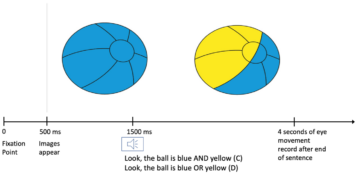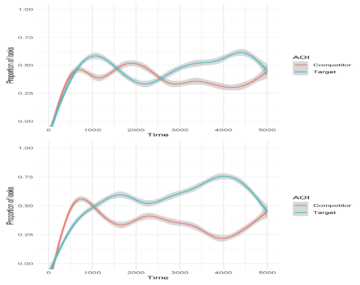by David J. Lobina

Imagine I place you in front of a computer screen, show you the image of two coloured shapes – e.g., a yellow triangle and a red circle – and then ask you if the sentence the triangle is yellow and the circle is red describes the image. You’ll very quickly answer that it does indeed, and then you’ll probably ask me what gives – was that a tricky question? (It wasn’t.) But what if I ask you whether the sentence the triangle is yellow OR the circle is red describes the same image? Don’t imagine it and don’t answer the question – I once ran this experiment, so go and read it! The short of it is that adults do accept the OR sentence as a description of an image of a yellow triangle and a red circle, though to a lesser extent than with the AND sentences. (A previous 3QD entry discusses some of this; here.)
What if I then tell you that young children, between the ages of 3 and 6, treat disjunction or and disjunctive sentences such as [the triangle is yellow] or [the circle is red] not as the disjunction of formal logic, which is the usual case in adults – namely, such sentences are true if one or both clauses are true (a clause is what appears within brackets) – but as if disjunction and disjunctive sentences were conjunction and and conjunctive sentences – that is, for young children disjunctive sentences are only true if both clauses are true (to wit, the triangle is yellow AND the circle is red) and not true if only one of the clauses is true.
This particular result has been obtained in a few experiments, and though it is regarded as a mistake – disjunction ought to allow for a situation when only one clause is true, otherwise why use disjunction instead of conjunction?! – it does seem to tell us something about how children acquire the logical connectives and and or (the usual story is that children’s semantic and pragmatic abilities do not develop paru passi).
I gave this sort of experimental undertaking a go recently by focusing on much younger children, the so-called “terrible twos” (around 24 month old), as the children from previous experiments tend to have an average age of 4 years, and by then children already manifest rather sophisticated linguistic abilities. And to that end we used the so-called intermodal preferential looking paradigm (the IPLP). The IPLP has been successfully used to study the acquisition of grammatical phenomena with children as young as 13-15 months and has been especially useful with children aged 18 months and above, so perfect to our purposes!
The IPLP itself consists in measuring children’s differential visual fixations to two images or videos presented side-by-side as linguistic audio is being played over speakers or headphones. One of the images constitutes the target, which is usually presented during the familiarisation phase of an experiment, and it is the image the audio directs children to look at (any given experiment is composed of a training or familiarisation phase, to accustom participants to what they have to do, etc., and a testing or experimental session, where the actual experiment takes place). And another image plays the role of a distractor or competitor and is usually introduced for the first time during the experimental session itself, thereby maximising the surprise factor and thus potentially drawing the attention of children to it and away from the target – the idea is that you want to have reliable evidence for the conclusion that children are really understanding the sentences they are being exposed to in the way one is postulating that they do, and so you employ competitors, distractors, and surprise factors to tease the underlying abilities apart properly.
Given such a set-up, then, if children pay more attention to the images that the audio actually describes rather than to the novel distractors, the data would indicate that children are indeed demonstrating knowledge of the linguistic feature they are being evaluated on. Crucially, the IPLP can be combined with an eye tracker, allowing researchers to accurately identity where on a screen children’s gazes are fixated, for how long, and the time course these take, thereby producing moment-to-moment information on language processing.
Is what I am describing hard to imagine?

The figure above may help, as it shows the experimental flow of the task children undertook in this experiment. At the beginning of each trial children saw a fixation point – a cross – in the middle of the screen, directing their gaze to the centre of the screen, and the eye tracker started following their gaze from then on. 500 ms after the images appeared on the screen – one uni-coloured ball on one side of the screen, a bi-coloured ball on the other – these staying on the screen until the end of the trial. 1000 ms after the audio would play one of the target sentences (C or D in the graphic), and after the sentences ended the eye tracker would continue to record children’s gaze data for a further 4 seconds (in the event, this was useless). The idea is that eye movements are indicative of children’s implicit processing of the sentences they are hearing – that is, eye movements indicate how they are interpreting the sentences – without the need to ask them to do anything at all, an attractive proposition with children so young, and one that has proven very fruitful and robust in the study of child cognition.
What might have happened then? That is, what are your hypotheses or predictions here? In the C condition surely children focused on the bi-coloured ball, whereas in the D condition there might have been a question mark on this.
The graphics below show the proportion of looks of children to C (top graphic) and D (bottom graphic) for a total of 5000 ms (roughly, to the end of the sentences), where Target is always the bi-coloured ball and the Competitor is the uni-coloured ball (in both conditions).

What does this mean? For a start, children seem to have been a bit uncertain in the C condition, as they switched between Target and Competitors a few times, and even though they seemed to have settled on the Target interpretation, this was at a slightly over 50% chance of looking at the bi-coloured ball, which is not much (in fact, the analyses showed this to not be statistically significant). In the D condition, on the other hand, children settled on the Target interpretation fairly early on and did not divert from it – that is, children favoured a true-true reading of disjunction (i.e., both clauses are true, so they focused on bi-coloured balls) more clearly than they favoured a true-true reading of conjunction. Maybe.[i]
Let me explain the results differently: toddlers clearly discriminate between conjunction and disjunction, as shown by the differing performance on each condition, and whilst their preferred reading of disjunction is the true-true interpretation, even when contrasted with an either/or reading (the most common interpretation in older children and adults, and what they saw in the familiarisation phase to boot), they do not show a preference for the only possible interpretation that conjunction can receive (also the true-true reading).
It will be useful to explain the results by considering some of the features of the IPLP experimental task. As alluded to earlier on, the IPLP is quite sensitive to surprisal effects, and as a result special care must be exercised in its design. In the familiarisation phase of this experiment, bi-coloured balls were paired with conjunctive sentences and uni-coloured balls were paired with disjunctive sentences (for a sentence such as the ball is blue or yellow, a blue ball appeared on one side of the screen, and a yellow one on the other). In the experimental phase, children would see a bi-coloured ball on one side of the screen and a uni-coloured ball on the other side in each trial, and thus the surprisal effect would be expected to be triggered by the uni-coloured ball in the conjunction condition and by the bi-coloured ball in the disjunction condition, as these were not the pairings children had observed during the familiarisation phase. This is not exactly what happened.
One reason for this is the fact that the task was not a purely perceptual task, where surprisal effects are strongest, but a language comprehension task with a perceptual component (the IPLP can be used with much younger, pre-verbal children, where no linguistic input is needed and the aim in this case is quite different). In fact, it might be expected for language comprehension processes to mitigate the strength of the surprisal effect, and this is what was in fact observed.[ii]
The situation is as follows, then. In the conjunction condition, children would be expected to be drawn to the novel image (the uni-coloured ball) as the result of a surprisal effect, an image they would then reject as an interpretation for conjunction, eventually fixating on the bi-coloured ball instead. Toddlers may indeed have been drawn to the competitor image, as indicated by the switches shown in the figure above, but fixations on the novel image were not consistent in this condition, plausibly as a result of comprehension processes inhibiting the surprisal effect – that is, children might have considered the uni-coloured ball, but would not have accepted it as a reading of conjunction, and quickly so. Nevertheless, children did not then clearly fixate on the target for the remainder of the trial and there were no significant differences between the target and the competitor in this condition.
In the disjunction condition, the bi-coloured ball constitutes the novel image and it did draw children’s attention to it; but, crucially in this condition, this image is compatible with the meaning of so-called inclusive disjunction (viz., the sentence is true if one or both clauses are true). As it transpired, children stayed on this image for the rest of the trial, thereby demonstrating that they accept disjunction as inclusive disjunction. In this case, then, the surprisal effect was (also) operative, establishing which image children first fixate on, and given that children accept this reading, they do not deviate from it. Indeed, and this is telling, children do not switch from the true-true interpretation for the remainder of the trial, as they do not seem to have favoured so-called exclusive readings (that is, the either/or reading).
This does not mean that children are (mistakenly) treating disjunction as if it were conjunction, as in some experiments mentioned above; more likely, children this young cannot compute an exclusive reading from inclusive disjunction, which is how adults interpret disjunction (again, see here).
The argument may be a bit tortuous, so let me make it as explicit as possible. I am saying that a surprisal effect is at play in these data, and that this effect applies differently in each condition. At first sight, toddlers go to the bi-coloured ball in the disjunction condition on account of the surprisal effect, whilst they do not seem to go to uni-coloured balls in the conjunction condition in quite the same way. I propose the following explanation for this observation: there is a surprisal effect in the conjunction condition but the novel image is not compatible with the meaning of conjunction, children quickly reject this interpretation, the novelty is not long-lasting, and thus the surprisal effect is inhibited; and in the disjunction condition, the novel image is compatible with the meaning of inclusive disjunction and thus toddlers do not move away from it once the novelty has decreased, as they accept the image as a match for disjunction.
Putting it all together, then. The results show discrimination between conjunction and disjunction by our toddlers (average age: 28-month-old), and also discrimination between target and competitor, per condition, thus showcasing the very early comprehension of both inclusive disjunction and conjunction (though, in the case of the latter, indirectly so). The surprisal effect typical of the IPLP is modulated and inhibited by what interpretations of conjunctive and disjunctive sentences are entertainable by children, and this goes one direction in the case of conjunction, and in another direction for disjunction.
Why is this important at all?
Well, there is a question as to whether acquisitional data of this kind can inform on the sort of primitives there might be in language and thought, especially in terms of the logical vocabulary (in this case, the logical connectives). As an example, in a study on how young children reason with the disjunctive syllogism (viz., p or q and not-q, therefore p), it is reported that children below the age of 3 do not appear to employ the syllogism, and this may be related to the apparent fact that English or is not used properly until about age 3. How so? In order to employ the syllogism, one would presumably have to have the concepts OR and NOT (we use capitals for concepts, as per the norm), and one way to figure out whether these concepts are available at a certain age is to find out how early in ontogeny the corresponding words are acquired. If there is a large temporal gap between a given word and it being given the appropriate meaning, we could then conclude that there was no corresponding concept in thought before the acquisition of the relevant lexical item.
The idea here is that the earlier on a vocabulary is acquired in language acquisition, the more likely it is that this vocabulary will be part of a language of thought. And given that the previous literature indicates that the logical vocabulary is acquired relatively late (around the age of 3), conjunction and disjunction would not be part of thought ab initio.
This is not the place to settle this issue, obviously, but I do want to emphasise that our data shows that children have conjunction and and inclusive disjunction or relatively early.
[i] For geeks out there, we ran generalised additive mixed model to analyse the data. More information and data not available upon request (wait upon publication of these results!).
[ii] By the way, in each experimental trial, we presented the images side by side for 1000 ms before the sentence started, and the eye-tracking record shows that toddlers did not direct their fixations to any particular image in the absence of linguistic input. We had included this 1000 ms segment as a baseline in order to control for any possible biases, but none arose.
Enjoying the content on 3QD? Help keep us going by donating now.
